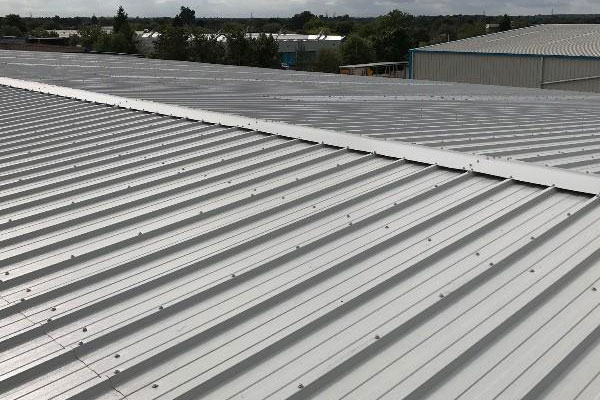The roof can be deemed as the first line of defense for commercial or industrial buildings, protecting from natural hazards such as wind, rain, fire, hail, ice, snow, and extreme heat. It is also the most vulnerable part of your building. Every day, your roof is exposed to weather and other elements that may contribute to decay and deterioration, increasing the risk of damage to the roof itself and the content below it. A lesser-quality roof may not stand up to the rigors of your regional weather. A roof must keep out all water and moisture. Energy-efficiency of a good quality roof is another important attribute. Estimates run as high as 50 percent for energy loss due to inefficient roofs. This can apply as much to the loss of cool air in hot summers as it does to heat loss in winter. Think of that in terms of money out the window. It’s an unnecessary loss. Fortunately, solutions do exist to improve your roof’s energy efficiency. There are different types of roofing available but selecting the apt one is the key. Given below are some of the best options for commercial and industrial roofing.
Structural and non – structural Metal Roofing
Structural metal roofing is directly attached to purlins and eliminates the need for any solid support beneath, non structural metal roofing requires some solid support beneath in the form of plywood, a metal roof deck etc. Non-structural systems would include tiles, corrugated metal roofing as well as panels. Metal roofs are available in sheets and sections. Sheets that come in standard sizes can be cut whereas sections are usually custom-built. Custom-made panels made of high-quality metal roofing are fastened with screws and rubber washers and can simulate the looks of slate, tiles etc. The most commonly used metal roofing materials for warehouses include steel, aluminum, copper, zinc, and titanium.These materials are also known for their durability in extreme weather—especially when it comes to preventing hail damage on roofing, which is a growing concern in storm-prone regions. Metal alloys in different colours, styles and textures are also available.

Built-Up Roofing
Built-Up Roofing systems generally are composed of alternating layers of bitumen and reinforcing fabrics that create a finished membrane. Sometimes, a base sheet, used as the bottommost ply, is mechanically fastened. Built-up roofs generally are considered to fully adhere if applied directly to roof decks or insulation. The reinforcing fabrics also are called roofing felts or ply sheets. Roofing felts are reinforced with either glass-fiber mats or organic mats.

Modified bitumen Roofing
Modified bitumen is a type of asphalt product that can be applied in several ways to the roof in both hot and cold temperatures. Modified bitumen roofs have a lot of advantages over other types of membrane roofing, and are often seen as the modern alternative to the built-up roof. Unlike some newer types of roofing, it has a long, proven track record that can be counted on. Modified bitumen roofs are one of the longer-lasting types of flat roofing materials, easily lasting 20 years or more. Modified bitumen roof is also very durable. They have a high-tensile strength so they are unlikely to develop the kinds of cracks that other flat and membrane roofs are known for. They are also rated against wind, fire, and hail so they are unlikely to be damaged in the event of a storm. Included in this is usually a very long manufacturer’s warranty that can help to guarantee the roof’s longevity.
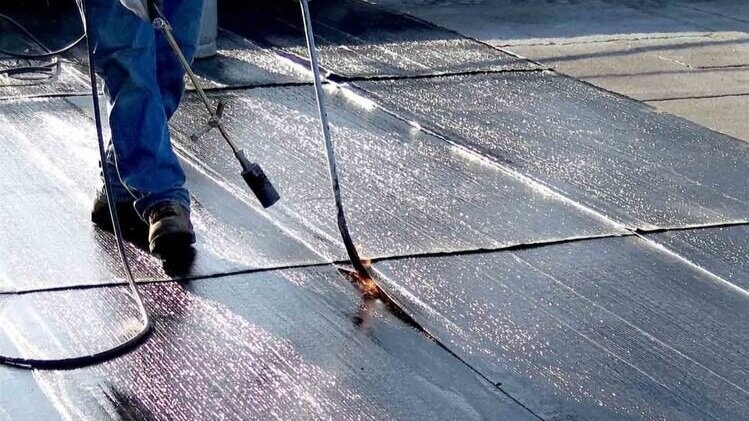
Twin Skin Roofing
The Twin Skin Roof offers rapid coverage and swift completion of a weatherproof building envelope to give a high-performance building. Limiting air infiltration and minimizing the risk of interstitial condensation can be achieved by sealing the laps of the inner lining sheet, incorporating a vapour control layer and sealing around gaps and service penetrations in the roof. The structural framing, inner liner sheet, metal spacer brackets (with thermal break) and sheeting rails are installed following the manufacturer’s instructions. Twin Skin Systems also offers building occupants a reduced noise level from outside influences, as the system offers an effective acoustical reducing solution.
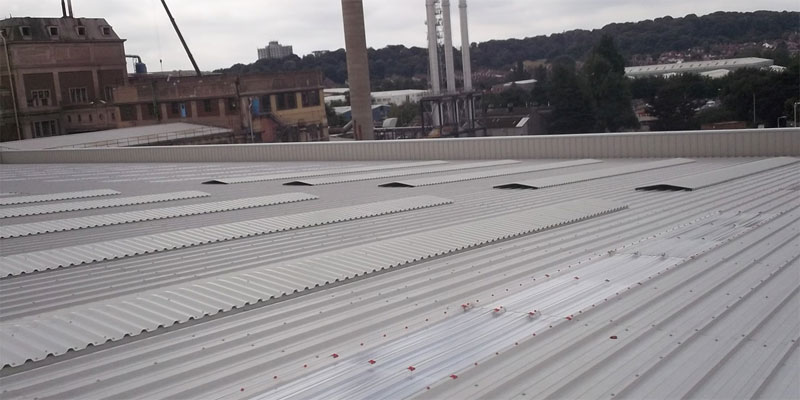
Composite Roofing
Composite roofing is probably the most commonly selected system used for warehouse roofing and cladding. It comprises a pre-assembled roofing structure with insulation and support sandwiched between the upper and lower roofing panels; and can easily be fixed and assembled to construct the roof. It is essentially the same material as a Twin Skin but the main difference between the two is that Composite is supplied as a ‘ready to fit’ product; making it quick to install.
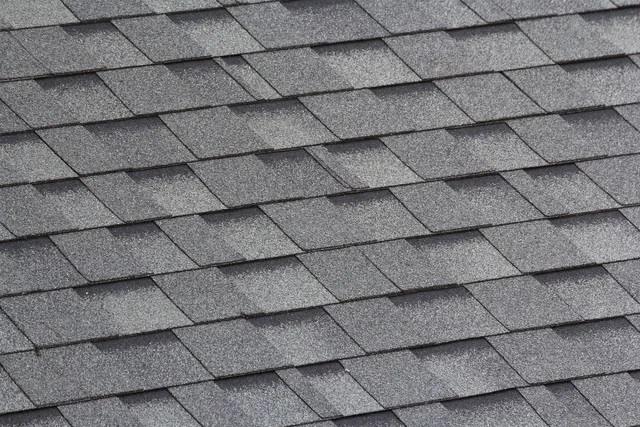
TPO Roofing
TPO stands for thermoplastic polyolefin, a single-ply roofing membrane that covers the surface of the roof. The name is a bit misleading because rather than being a plastic, TPO is actually one of a few different types of rubber, usually a blend of polypropylene and ethylene-propylene rubber. TPO is one of the cheapest materials on the market today, costing less than EPDM or other types of rolled rubber roofing. The other biggest positive to using TPO is its color. This type of roofing is white on top, which can help to reflect the sun’s light and stop heat buildup within the building. Other positives include the fact that you have choices in how it is installed; it can be attached with adhesives or fastened directly to the roof deck. It can also be heat-welded in places around chimneys and other protrusions.

EPDM Roofing
EPDM roofing is most commonly known as rubber roofing, rubber membrane roofing, or rolled rubber roofing. It’s made of a mixture of recycled tires, sawdust, and slate dust and runs roughly .80 a square foot, making it one of the least expensive types of roofing on the market today.
It’s also extremely easy to install, so whether you do it yourself or you hire a professional, the costs are low in that area as well. EPDM rubber roofing is also very lightweight, so the roof deck doesn’t need any kind of reinforcement.

Photovoltaic solar panels Roofing
Photovoltaic solar panels absorb sunlight as a source of energy to generate electricity. A photovoltaic (PV) module is a packaged, connected assembly of typically 6×10 photovoltaic solar cells. Photovoltaic modules constitute the photovoltaic array of a photovoltaic system that generates and supplies solar electricity in commercial and residential applications. The most common application of solar energy collection outside agriculture is solar water heating systems.
Photovoltaic modules use light energy (photons) from the Sun to generate electricity through the photovoltaic effect. The majority of modules use wafer-based crystalline silicon cells or thin-film cells. The structural (load carrying) member of a module can either be the top layer or the back layer. Cells must also be protected from mechanical damage and moisture. Most modules are rigid, but semi-flexible ones based on thin-film cells are also available. The cells must be connected electrically in series, one to another.
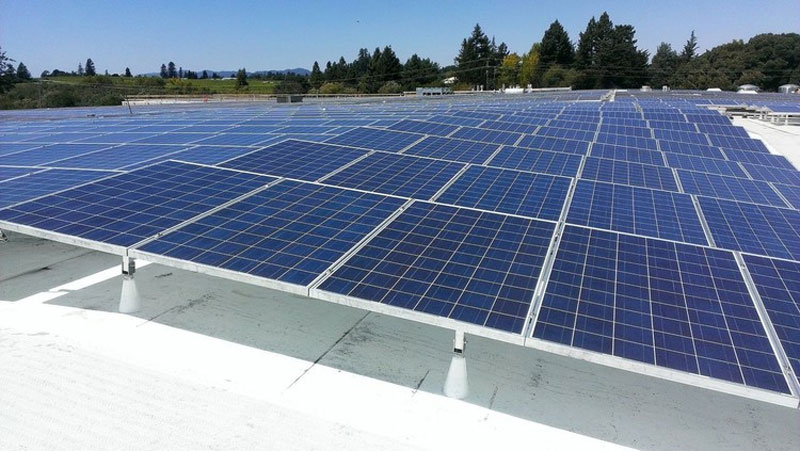
Green Roofing
A green roof or living roof is a roof of a building that is partially or completely covered with vegetation and a growing medium, planted over a waterproofing membrane. It may also include additional layers such as a root barrier and drainage and irrigation systems. Green roofs serve several purposes for a building, such as absorbing rainwater, providing insulation, creating a habitat for wildlife, increasing benevolence and decreasing stress of the people around the roof by providing a more aesthetically pleasing landscape, and helping to lower urban air temperatures and mitigate the heat island effect. Green roofs are suitable for retrofit or redevelopment projects as well as new buildings and can be installed on small garages or larger industrial, commercial and municipal buildings. They effectively utilize the natural functions of plants to filter water and treat air in urban and suburban landscapes.


